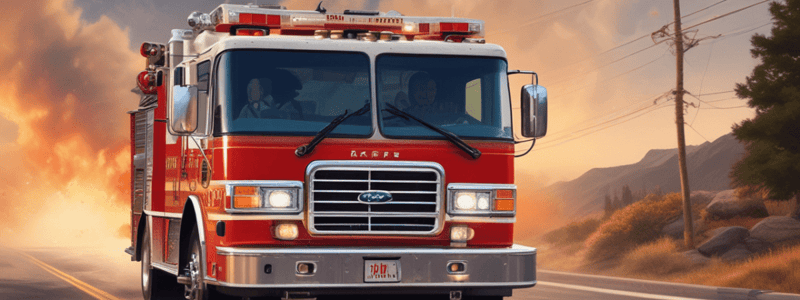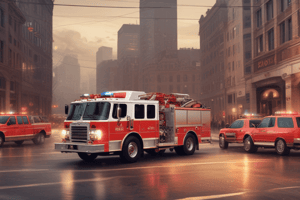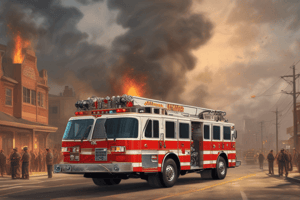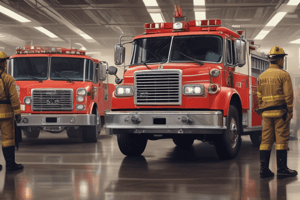Podcast
Questions and Answers
Under which circumstance should KCFD vehicle operators stop their vehicle during an emergency response?
Under which circumstance should KCFD vehicle operators stop their vehicle during an emergency response?
- At railways when other vehicles stop
- During a fire drill
- When encountering a stopped school bus with flashing warning lights (correct)
- When driving over the posted speed limit
What is the maximum speed at which emergency vehicles are allowed to exceed the posted speed limit?
What is the maximum speed at which emergency vehicles are allowed to exceed the posted speed limit?
- 20 miles per hour
- 25 miles per hour
- 15 miles per hour (correct)
- 10 miles per hour
What must KCFD vehicle operators do when arriving at unguarded railroad grade crossings?
What must KCFD vehicle operators do when arriving at unguarded railroad grade crossings?
- Wait for instruction from another vehicle
- Proceed quickly to avoid delays
- Sound the sirens before crossing
- Stop and ensure safety before crossing (correct)
What responsibility do KCFD vehicle operators have when using warning devices?
What responsibility do KCFD vehicle operators have when using warning devices?
Which of the following is NOT a circumstance that requires KCFD vehicle operators to bring their vehicle to a complete stop?
Which of the following is NOT a circumstance that requires KCFD vehicle operators to bring their vehicle to a complete stop?
What should KCFD personnel do when directed by law enforcement officers during an emergency response?
What should KCFD personnel do when directed by law enforcement officers during an emergency response?
When should KCFD vehicle operators stop at intersections?
When should KCFD vehicle operators stop at intersections?
Which of the following is a reason KCFD vehicle operators might NOT be granted the right of way?
Which of the following is a reason KCFD vehicle operators might NOT be granted the right of way?
Study Notes
KCFD Vehicle Operations Directive
- Directive 2023-1 issued by Interim Fire Chief Ross Grundyson on February 10, 2023.
- Aimed at enhancing the safety of KCFD personnel and citizens during vehicle operations.
Emergency Response Stopping Protocols
- KCFD vehicle operators must stop completely in various scenarios:
- When directed by KCFD personnel or law enforcement.
- At red traffic lights and stop signs.
- At negative right-of-way and blind intersections.
- If unable to see all lanes of traffic at an intersection.
- In presence of other hazard situations.
- When encountering stopped school buses with flashing lights.
- At railroad crossings with gate in the down position.
Railroad Crossing Guidelines
- KCFD operators must stop at unguarded railroad grade crossings, whether in emergency or non-emergency travel.
- Ensuring safety before crossing railroad tracks is mandatory.
Warning Devices and Right of Way
- Use of lights, sirens, and air horns does not guarantee right of way.
- Operators must clearly communicate presence and intentions to other drivers.
- Defensive driving is essential to account for unexpected actions by others.
Speed Limit Regulations
- Emergency vehicles may not exceed the posted speed limit by more than 15 miles per hour during operations.
Studying That Suits You
Use AI to generate personalized quizzes and flashcards to suit your learning preferences.
Related Documents
Description
This document outlines the KCFD's commitment to safety and the recent changes to vehicle operations effective February 10, 2023. All KCFD personnel are required to adhere to these new guidelines to ensure the safety of both employees and citizens during emergencies.




